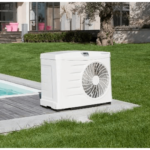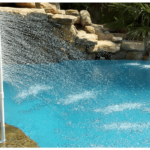Información actualizada April 7, 2024
Table of Contents
Introduction to Security Railings for Fiberglass Pools
Security railings for fiberglass pools play a crucial role in ensuring the peace of mind of owners and users. Safety in aquatic environments is essential, and understanding the importance of these railings is the first step in creating a safe and enjoyable aquatic space.
Security railings for fiberglass pools are referred to by various names throughout Spanish-speaking countries. These devices, also known as protective handrails, guardrails, or safety bars, serve an essential function in preventing accidents around aquatic areas. Their presence provides a vital containment element, ensuring the protection of those enjoying fiberglass pools by safely delineating the perimeter in recreational spaces such as pools.
Advantages of Security Railings in Fiberglass Pools
Security railings in fiberglass pools offer various advantages to ensure a safe and protected environment around the aquatic area. Using synonyms for “railing,” we can highlight the benefits of safety handrails in this context:
1. Protection Handrails:
– Provide a solid and sturdy handrail that ensures the protection of those moving around the pool.
2. Containment Bar:
– Act as a solid containment bar, providing additional support to prevent accidental falls.
3. Safety Bar:
– Function as an essential safety bar, especially in areas where the surface may become slippery.
4. Guard Fence:
– Form part of a guard fence, clearly delineating the perimeter of the pool and reducing the risk of unauthorized access.
5. Protective Railing:
– Serve as a protective railing around the pool edge, offering a physical barrier against potential hazards.
6. Backing Element:
– Act as a solid backing element, providing support and security to those enjoying the aquatic environment.
7. Safety Corridor:
– Create a safety corridor around the pool, facilitating movement without compromising protection.
8. Guard Rail:
– Form part of an essential guard rail to prevent accidents around the pool area.
9. Protective Handrail:
– Act as a protective handrail contributing to maintaining a safe and risk-free environment.
10. Edge Defense:
– Provide edge defense, ensuring that the area around the pool is equipped with appropriate safety measures.
Importance of Security Railings for Fiberglass Pools
Concerning statistics on pool accidents underscore the need to implement rigorous safety measures. We will explore the key regulations that pools and railings must comply with.
Fiberglass pools have gained popularity in recent years due to their durability, easy maintenance, and aesthetic design. Although these pools offer numerous benefits, it is crucial to emphasize the importance of safety in their use. Pool safety is essential not only for preventing accidents but also for promoting
the peace of mind and enjoyment of users. Concerning statistics on pool accidents underscore the need to implement rigorous safety measures. We will explore some of the key regulations that pools and railings must comply with.
Firstly, railings help prevent accidental falls by providing additional support to users around the pool. This is particularly important in areas where the surface may become slippery due to water, acting as a secure grip point during entry or exit from the water.
Additionally, railings enable effective control of pool access:
Their strategic installation next to stairs or entry points helps prevent unauthorized entry, thereby promoting overall area safety. They act as a physical barrier that discourages young children or vulnerable individuals from accessing the pool unsupervised, reducing the risk of accidents.
Moreover, railings facilitate entry and exit from the pool, offering essential support, especially for the elderly or those with reduced mobility. Besides their primary safety function, these structures also contribute to the aesthetic design of the pool, enhancing the overall appearance of the area without compromising safety.
The presence of railings not only has a practical impact in preventing accidents but also raises users’ awareness of safe areas around the pool. Additionally, their installation may be a regulatory requirement in many places to comply with specific pool safety regulations, ensuring compliance and avoiding penalties.
Therefore, we can say that their presence in pools is essential for accident prevention, access control, and compliance with specific regulations, contributing to the enjoyment and peace of mind of those who enjoy these recreational spaces.
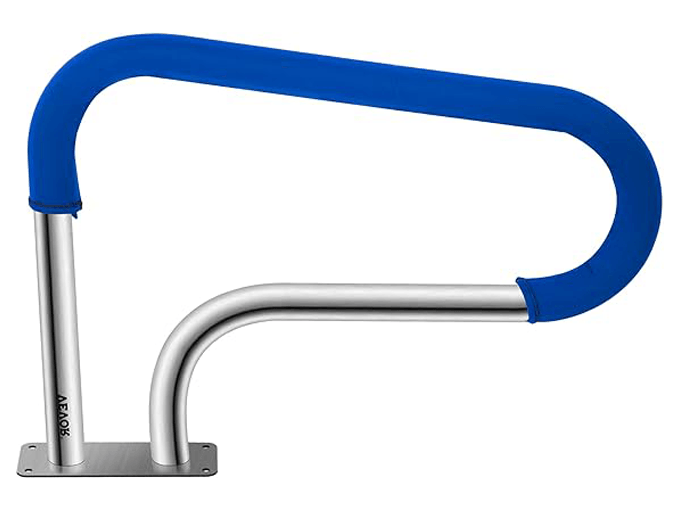
Essential Features of Safety Railings
From the appropriate height to weather resistance, we will discover the essential features that safety railings must-have for effectiveness.
1. Corrosion-Resistant Material:
– Railings should be made of corrosion-resistant materials as they will be constantly exposed to moisture and chemicals present in the pool environment.
2. Non-Slip Surface:
– The surface of the railings should be non-slip to provide a secure grip even when wet. This is essential for preventing accidents around the pool.
3. Proper Height:
– The height of railings should comply with local and national regulations to ensure an effective barrier. Generally, a minimum height is recommended to prevent falls and ensure safety.
4. Structural Strength:
– Railings must have adequate structural strength to withstand loads and provide solid support. This is especially important in areas where people are expected to lean, such as when going up or down stairs.
5. Ergonomic Design:
– The design of railings should be ergonomic, providing a comfortable and secure grip. This is crucial to ensure that users feel confident when using the railings for support.
6. Easy Installation:
– Railings should be easy to install securely and effectively. Simple installation facilitates the implementation and maintenance of safety measures.
7. Durability Against Weather Elements:
– Since railings will be exposed to the elements, they should be durable and able to withstand prolonged exposure to weather elements such as sunlight and temperature variations.
8. Compliance with Safety Regulations:
– It is crucial for railings to comply with all local and national regulations related to pool safety. This includes specific requirements regarding height, strength, and design.
9. Easy Maintenance:
– Railings should be easy to maintain to ensure their functionality over time. Materials that do not require frequent maintenance contribute to sustainability and efficiency in pool safety management.
10. Integrated Aesthetics:
– Although safety is paramount, railings can also contribute to the aesthetic design of the pool. A design that integrates harmoniously with the surroundings enhances the overall aesthetics of the area.
By selecting and maintaining railings with these essential features, a safer and more functional environment around fiberglass pools is ensured.
Correct Installation of Railings
Correct installation is crucial for the effectiveness of railings. This involves careful selection of design and materials, strategic placement, precise measurement, and thorough verification at the end of the process. This meticulous approach ensures not only compliance with regulations but also a safe, functional, and aesthetically pleasing aquatic environment for pool users.
Attractive Styles and Designs
Safety does not have to compromise aesthetics. By exploring the various existing styles and designs of railings, we can note that they not only meet safety standards but can also be integrated harmoniously with the overall pool design, creating a positive visual impact.
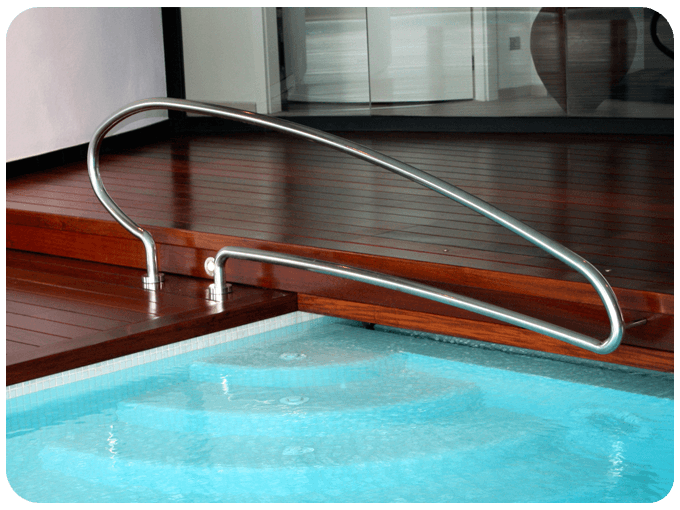
Maintenance of Fiberglass Pool Railings
Regular maintenance is essential to ensure the long-term durability and effectiveness of railings. Regular inspections, careful cleaning, repair or replacement of affected areas, and verification of structural stability should be carried out. This proactive approach ensures that railings fulfill their safety function.
Searching for Quality Safety Railings
For those looking for railings, it is important to conduct thorough research on brand reputation, compliance with regulations, materials used, design and ergonomics, as well as review product reviews and customer testimonials. These guidelines will help make informed decisions and ensure the acquisition of products that meet the desired safety and quality standards.
Local and Global Pool Safety Regulations
Adapting to local regulations and complying with international standards is crucial. We will detail how railings must conform to various regulations to ensure safety.
Global regulations that must be considered to ensure the safety of railings may vary depending on the location and specific use of the facilities. However, some international regulations and standards that are often relevant include:
1. ISO 14001 and ISO 9001:
– ISO 14001 standards focus on environmental management, and ISO 9001 on quality management. Although not directly related to railings, complying with these standards can indicate the manufacturer’s commitment to sustainable production practices and quality control.
2. ASTM International Standards:
– ASTM F2656 and ASTM F3111 establish standards for safety barriers, including strength testing and design requirements. Also addresses barriers around pool and spa areas.
3. International Swimming Pool and Spa Code (ISPSC):
– This code provides international regulations for the construction and safety of pools and spas, including requirements for barriers and safety devices.
4. U.S. Consumer Product Safety Commission (CPSC) Standards:
– CPSC standards influence the safety of products used in pools and spas, including railings. Compliance with these standards may be crucial for products intended for the U.S. market.
5. Occupational Safety and Health Administration (OSHA) Regulations:
– In some cases, OSHA regulations may apply, especially in commercial or public use environments, to ensure the safety of staff and visitors.
It is essential to note that these are general guidelines, and specific regulations may vary depending on geographical location and the particular application of railings. It is recommended to consult and comply with local and national regulations to ensure safety and regulatory compliance.
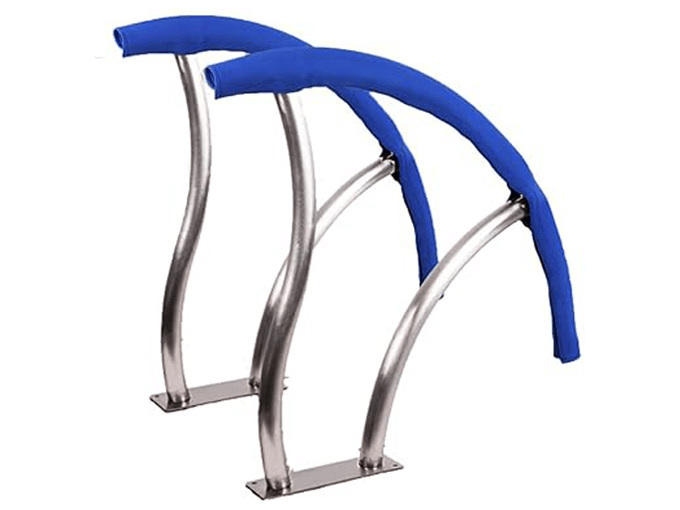
Demystifying Common Pool Safety Practices
We will address common myths that may lead to unsafe practices to promote awareness and accident prevention. Some of the most common myths include:
1. “Swimming alone is safe if you are a good swimmer”:
– This myth assumes that only experienced swimmers are exempt from risks. In reality, everyone, regardless of skill level, should follow safety precautions, as accidents can happen to anyone.
2. “Children naturally float if they sink”:
– This myth can lead to the false belief that children will always float and are not at risk of drowning. In reality, constant supervision and safety measures are essential, as children can sink quickly.
3. “Pool alarms are sufficient for safety”:
– Relying solely on alarms can be dangerous. Although they are useful as an additional tool, they do not replace active supervision and other safety barriers, such as fences and covers.
4. “The presence of lifeguards eliminates all risks”:
– Although lifeguards are essential, they should not be considered a substitute for parental and caregiver supervision. Constant attention is crucial to prevent dangerous situations.
5. “The use of life jackets is unnecessary in small pools”:
– All pools, regardless of size, can pose risks. The use of life jackets is advisable, especially for children and individuals with limited swimming abilities.
6. “Shallow pools are safe without barriers”:
– Although the depth may be shallower, shallow pools still pose risks. Safety barriers are essential to prevent unauthorized access and dangerous situations.
7. “Drowning is always loud and easy to detect”:
– Contrary to popular belief, drowning often occurs silently. It does not always involve screams or audible signals, underscoring the importance of constant visual supervision.
8. “Pool covers are completely safe”:
– Although pool covers are useful, they should not be considered infallible. Not all models are resistant, and some may pose risks if not used properly.
Unique Frequently Asked Questions About Security Railings for Fiberglass Pools
Are safety railings really necessary for fiberglass pools?
• Yes, railings are essential to ensure the safety of all users, regardless of the type of pool.
What is the recommended height for safety railings?
• The appropriate height varies, but it is generally recommended that railings be at least 1.2 meters high to ensure effective protection.
Can I install safety railings myself?
• It is recommended to hire professionals to ensure proper and safe installation.
How can I maintain the railings in good condition?
• Perform regular cleanings with water and mild soap, and conduct periodic inspections to detect potential issues.
Are there customized railing options?
• Yes, many companies offer customized options to fit the unique design of your pool.
Conclusion
Security Railings for Fiberglass Pools are essential elements to ensure a safe, functional, and aesthetically pleasing aquatic environment. The combination of proper investments, professional installation, regular maintenance, and safety awareness contributes to the creation of enjoyable aquatic spaces free from risks.

